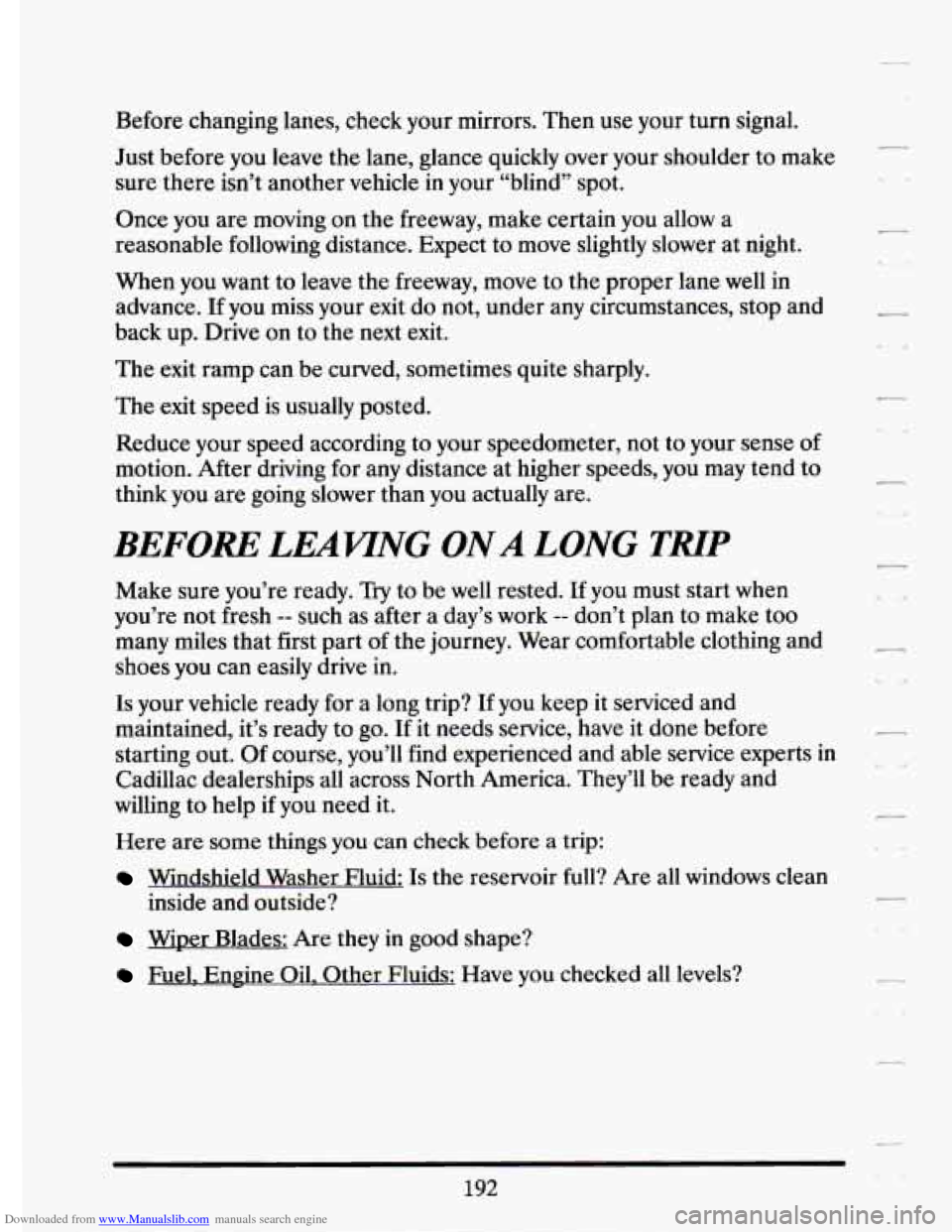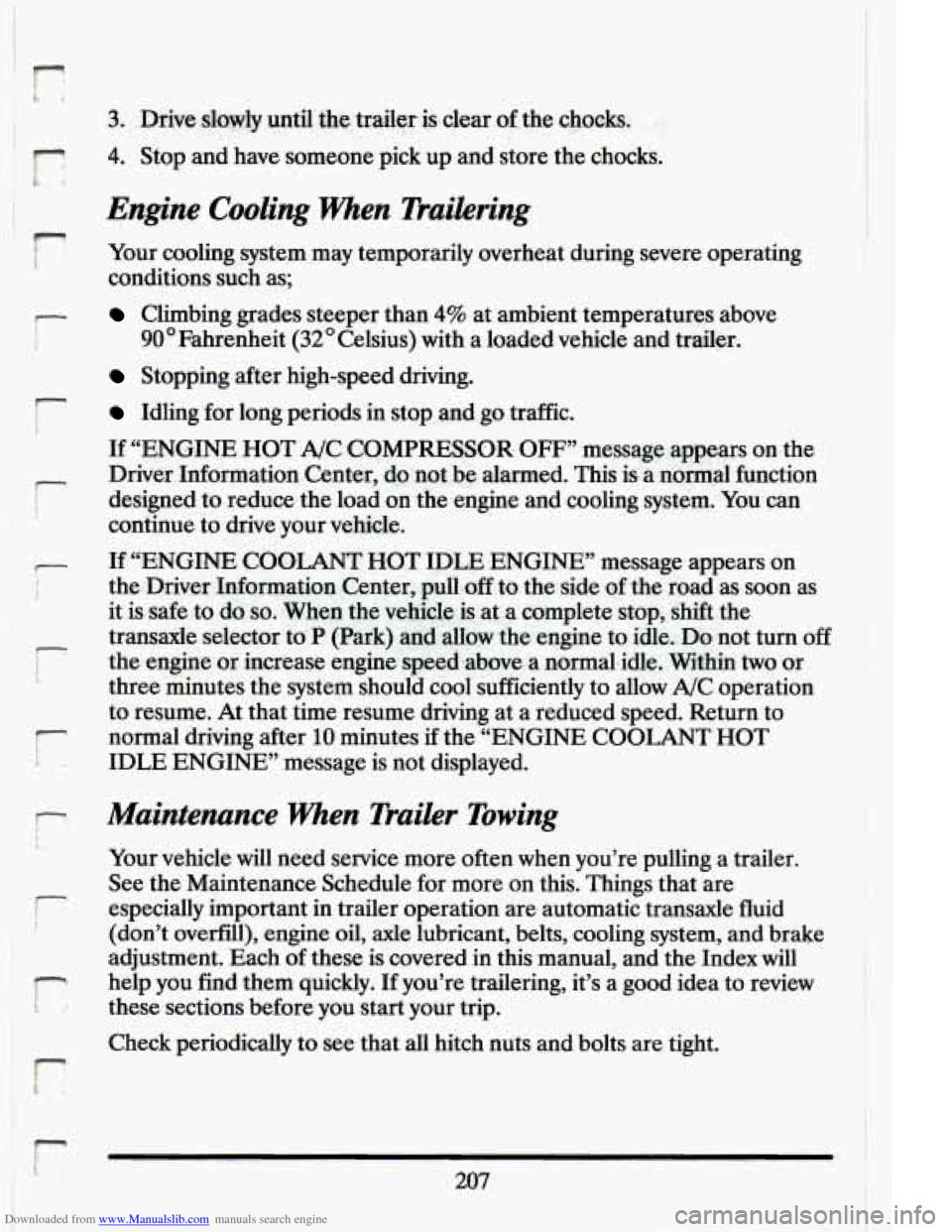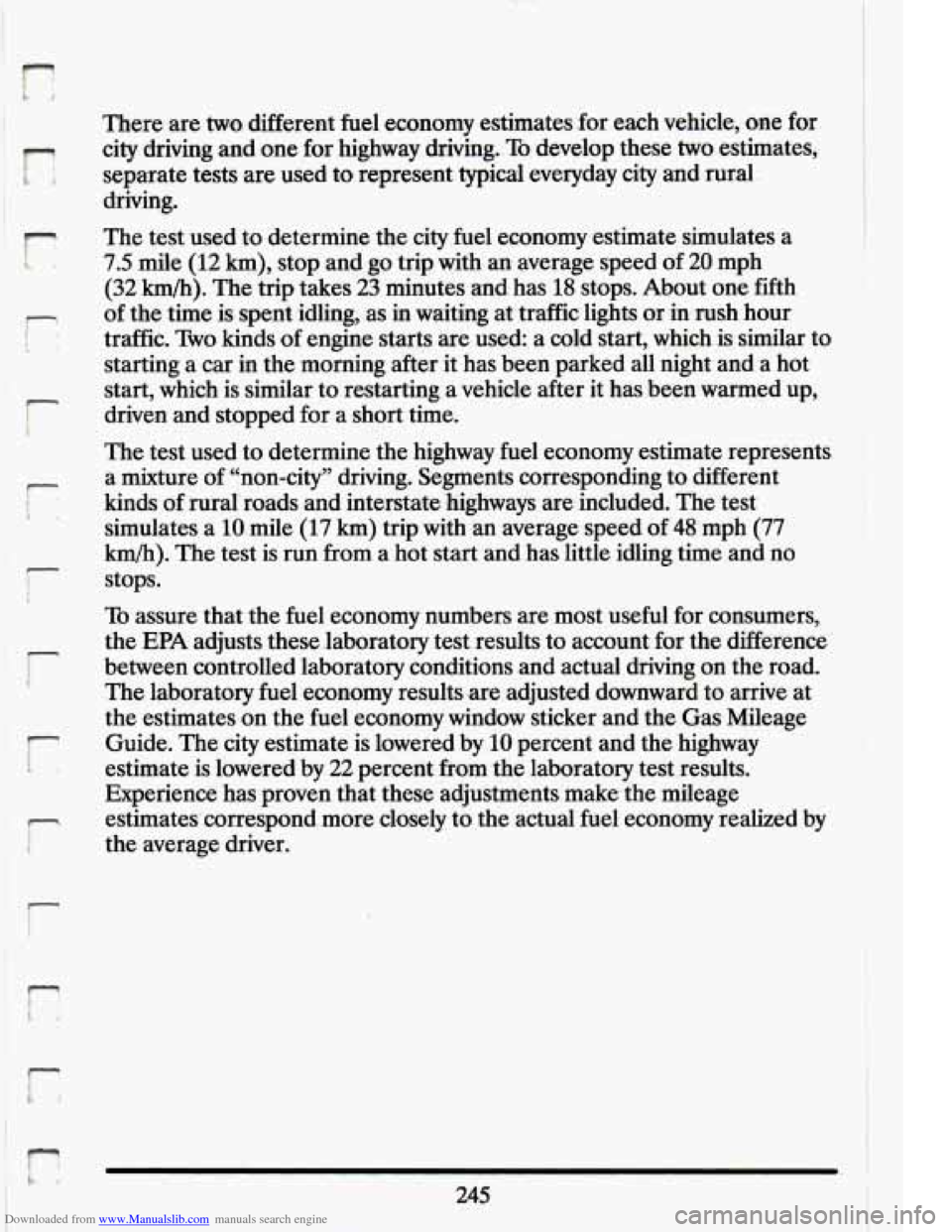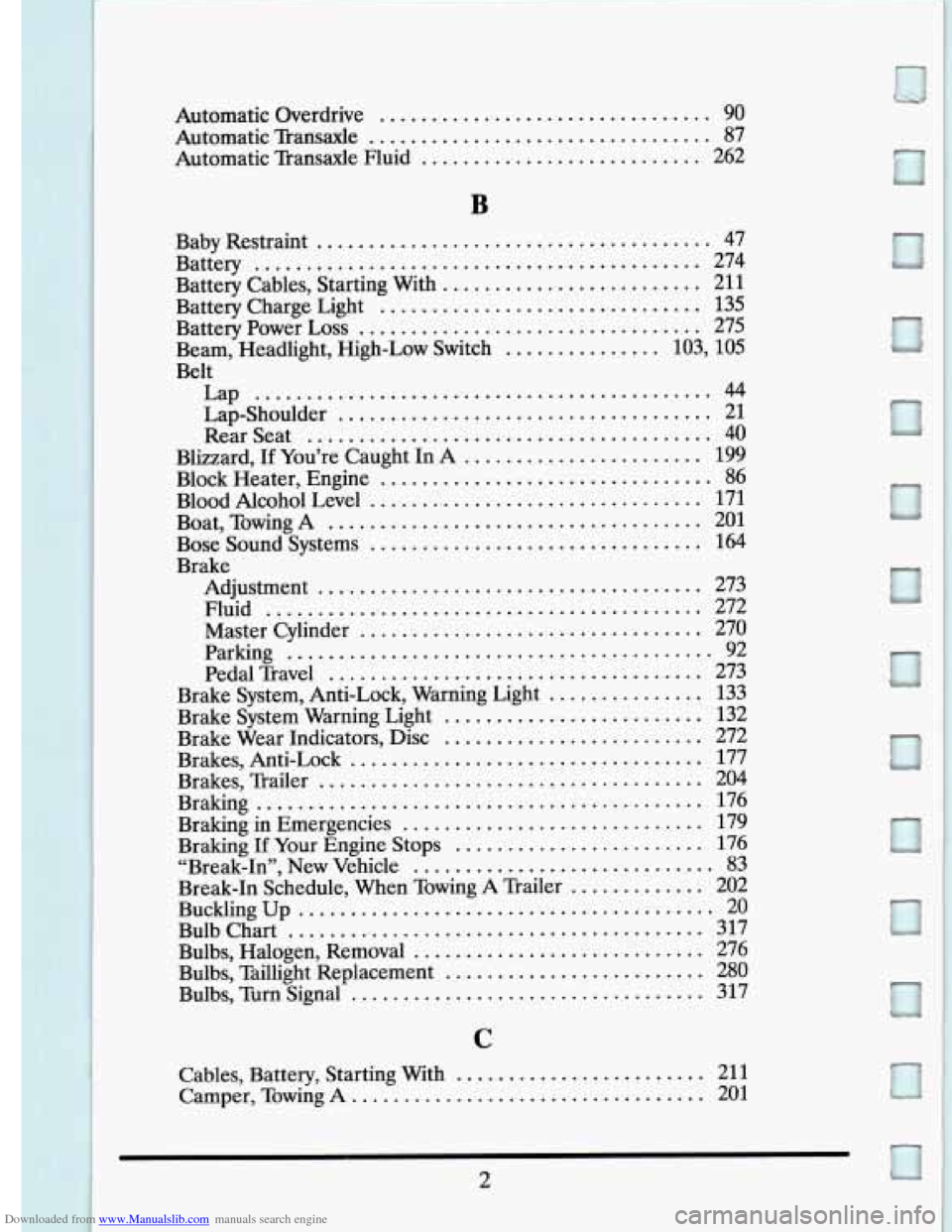1994 CADILLAC ELDORADO stop start
[x] Cancel search: stop startPage 204 of 398

Downloaded from www.Manualslib.com manuals search engine Before changing lanes, check your mirrors. Then use your turn signal.
Just before you leave the lane, glance quickly over your shoulder to make
sure there isn’t another vehicle
in your “blind” spot.
Once you are moving
on the freeway, make certain you allow .a
reasonable following distance. Expect to move slightly slower at night.
When you want to leave the freeway, move to the proper lane well
in
advance. If you miss your exit do not, under any circumstances, stop and
back up. Drive
on to the next exit.
The exit ramp can be-curved, sometimes quite sharply.
The exit speed is usually posted.
Reduce your speed according to your speedometer, not
to your sense of
motion. After driving for any distance at higher speeds, you may tend to
think you are going slower than you actually are.
BEFORE LEAVTNG ONA LONG THP
Make sure you’re ready. Try to be well rested. If you must start when
you’re not fresh
-- such as after a day’s work -- don’t plan to make too
many miles that first part of the journey. Wear comfortable clothing and
shoes you can easily drive in.
Is your vehicle ready for a long trip? If you keep it serviced and
maintained, it’s ready to go. If it needs service, have it done before
-
starting out. Of course, you’ll find experienced and able service experts in
Cadillac dealerships all across North America. They’ll be ready and
willing to help
if you need it.
Here are some things
you can check before a trip:
Windshield Washer Fluid: Is the reservoir full? Are all windows clean
inside and outside?
Wiper Blades: Are they in good,shape?
Fuel, Engine Oil. Other Fluids: Have you checked all levels?
-.
192
Page 219 of 398

Downloaded from www.Manualslib.com manuals search engine r
F, 4. Stop and have someone pick up .and store the chocks.
Engine Cooling When Tru.ilering
r
I ? Your cooling system may temporarily overheat during severe operating
conditions such as;
Climbing grades steeper than 4% at ambient temperatures above
90” Fahrenheit (32O Celsius) with a loaded vehicle and trailer.
Stopping after high-speed driving.
I
r Idling for long periods in stop and go traffic. I
If ,“ENGINE HOT A/C COMPRESSOR OFF” message appears on. the
Driver Information Center, do.not be alarmed.
This is. a normal function
continue to drive’your vehicle.
the -Driver Information Center, pull
,off to the side of the road as, soon as
it is safe to do
so. When the vehicle is at a complete stop, shift the
transaxle selector to
P (Park) and allow the engine to idle.:Do not turn off
three minutes the system should cool sufficiently to allow A/C operation
to resume. At that time resume driving at a reduced speed. Return to
normal driving after
10 minutes if the “ENGINE COOLANT HOT
- designed. to reduce the load on the.engine and cooling system. You can
- If “ENGINE COOLANT HOT IDLE ENGINE” message.appears on
c
I the engine or increase engine speed.above a normalidle. Wit-hin two or
b- IDLE ENGINE” message is not displayed.
Maintenance When Trailer Towing
i L.
Your vehicle will need service more often when you’re pulling a trailer.
See the Maintenance Schedule for more on this. Things that are
(don’t overfill), engine oil,
axle lubricant, belts, cooling system, and brake
adjustment. Each
of these is covered in this manual, and the Index will
these sections before you start your trip.
i especially important in trailer operation are, automatic transaxle fluid
7 help you find them quickly. If you’re trailering, it’s a good idea to review
I
‘F
Check periodically to see that all hitch nuts and bolts are tight.
r 207
Page 257 of 398

Downloaded from www.Manualslib.com manuals search engine r
I’
r
i
i-
i r
There: are two;different fuel economy estimates ,for each vehicle., one for.
city driving
and one for highway driving ... To develop these two .estimates,. ;
separate tests .are used to represent typical everyday city and rural
driving.
The test used to determine the city fuel economy estimate simulates a
7.5 mile (12 km), stop and go trip with. an average speed of 20 mph
(32 km/h). The trip takes 23, minutes and: has 18 stops. About one fifth
of the time is spent idling, as in waiting at traffic lights or in rush hour
traffic.
Two. kinds of engine starts are used: a cold start, which is similar to
starting a car in the morning after it has been parked all night and a hot
start, which is similar to restarting a vehicle after it has been warmed up,
driven and stopped for a short time.
I
!
i j I i
The test used to determine the highway fuel economy estimate represents
a mixture of “non-city” driving. Segments corresponding to different
kinds of rural roads and interstate highways are included. The test
simulates a
10- mile (17 km) trip with an average speed. of 48 mph (77
km/h). The test is run from a hot start and has little idling time and no
stops.
To assure that the fuel economy numbers are most useful for consumers,
the EPA adjusts. these .laboratory test. results. to account for the difference
between controlled laboratory conditions and actual, driving on the road.
The laboratory fuel economy results are adjusted downward
to arrive at
the estimates on the fuel economy window sticker and the
Gas Mileage
Guide. The city estimate is lowered by
10 percent and the highway
estimate is lowered by
22 percent from the laboratory test results.
Experience has proven that these adjustments make the mile:age
estimates-correspond more closely to the actual fuel economy realized
by
the average driver.
245
Page 326 of 398

Downloaded from www.Manualslib.com manuals search engine I 30AC.B. I
A
I I 60A
E
I 60A I
I I 50A
4
I 40A 1
n
LH MAXI8 FUSE BLOCK
FUSE 1 (50 AMP) (STRG 1-2)
- RETAINED ACCESSORY POWER (RADIO/WIPERS)
- STARTER
- TRUNK COMF FUSES 81 1 AND 813
FUSE 2 (60 AMP) (BODY)
- ENGINE COMI? B11
- ROAD SENSING SUSPENSION
- FOG LIGHTS
- TRUNK COMF! FUSE C1, C3, C5, C7, C9, AND
c11
- TRUNK COMF! FUSE C13 (EXPORT)
- REAR FOG LIGHT (EXPORT)
CIRCUIT BREAKER 3 (30 AMP) (SEAT)
- LEFT AND RIGHT POWER SEAT SWITCHES
- LEFT AND RIGHT LUMBAR RELAYS
- POWER DOOR LOCKS
- KEYLESS ENTRY MODULE
- HORNS
- FUEL DOOR RELEASE SWITCH - TRUNK RELEASE SWITCH
FUSE 4 (30 AMP) (IPC)
- POWERTRAIN CONTROL MODULE (PCM)
- ELECTRONIC CLIMATE CONTROL
- RAP/ILLUMINATED ENTRY MODULE
- INSTRUMENT PANEL CLUSTER
- PASS-Key@ DECODER MODULE
- THEFT DETERRENT
FUSE 5 (SO AMP) (HVAC)
- LEFT AND RIGHT HEATED SEATS
- ELECTRONIC LEVEL CONTROL (ELC)
- TRUNK LID PULL DOWN
- POWER ANTENNA
- REAR DEFOGGER
- LEFT AND RIGHT MIRROR DEFOGGERS
FUSE 6 (60 AMP) (STRG 3)
- RETAINED ACCESSORY POWER
(SUNROOF/POWER WINDOWS)
- ENGINE COMF! FUSES Dl, D3, D5
- TRUNK COMF! FUSES Al, A3, A5, Ai', A9
RH MAXI8 FUSE BLOCK
CIRCUIT BREAKER 1 (30 AMP) (DAB)
- RETAINED ACCESSORY POWER (RAP)
(SUNROOF/POWER WINDOWS)
FUSE 2 (30 AMP) (RADIO)
- DELCO-BOSE@ SPEAKERS
- RADIO CONTROL HEAD
- REMOTE RADIO RECEIVER
FUSE 3 (50 AMP) (COOL)
FUSE
4 (40 AMP) HVAC BLOWER (BLOWER)
- COOLING FANS
- HVAC POWER MOTOR
- A/C COMPRESSOR
FUSE 5 (50 AMP) ABS (BRAKES)
FUSE
6 (50 AMP) (LAMPS)
- BRAKE PRESSURE MODULATOR VALVE
- TURN FLASHER MODULE
- HAZARD FLASHER
- STOP/BTSI/CRUISE BRAKE SWITCH
- PARKING LIGHTS
- DAY TIME RUNNING LIGHTS (CANADA)
- ENGINE COME FUSES B1,W AND B5
- TRUNK COMF! FUSES Dl 1, Dl3
314
Page 382 of 398

Downloaded from www.Manualslib.com manuals search engine Automatic Overdrive ................................ 90
Automatic Tkansaxle
................................. 87
Automatic Transaxle Fluid
........................... 262
B
Baby Restraint ...................................... 47
Battery
........................................... 274
Battery Cables. Starting With
......................... 211
Battery Charge Light
............................... 135
Battery Power
Loss ................................. 275
Beam. Headlight. High-Low Switch
............... 103. 105
Belt Lap
............................................ 44
Lap-Shoulder
..................................... 21
RearSeat
....................................... 40
Blizzard,
If You’re Caught In A ....................... 199
Block Heater, Engine
................................ 86
Blood Alcohol Level
................................ 171
Boat, Towing A
.................................... 201
Bose Sound Systems
................................ 164
Adjustment
..................................... 273
Fluid
.......................................... 272-
Master Cylinder
................................. 270
Parking
......................................... 92
Pedal Travel
.................................... 273
Brake System, Anti-Lock, Warning Light
............... 133
Brake System Warning Light
......................... 132
Brake Wear Indicators, Disc
......................... 272
Brakes, Anti-Lock
.................................. 177
Braking
........................................... 176
Braking in Emergencies
............................. 179
Braking
If Your Engine Stops ........................ 176
“Break-In”, New Vehicle
............................. 83
Break-In Schedule, When Towing A Trailer ............. 202
Bucklingup
........................................ 20
Bulb Chart
........................................ 317
Bulbs, Halogen, Removal
............................ 276
Bulbs, Taillight Replacement
......................... 280
Brake
Brakes, Trailer
..................................... 204
Bulbs, Turnsignal
.................................. 317
C
Cables. Battery. Starting With ........................ 211
Camper. Towing
A .................................. 201
2